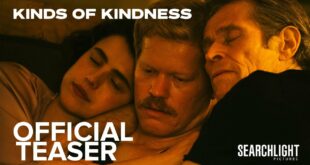[ad_1]
Greetings again from the darkness. It’s been too far long since my last “revisited” piece. These are meant to be a combination of movie review and historical perspective on a particular classic movie that I’ve watched yet again. My choice this time is NINOTCHKA, nominated for 4 Oscars (including Best Picture nominees) in what is widely considered one of cinema’s greatest years, 1939.
The roster of director, writers, producers, cinematographer, composer, set director, set decorator, editor, costume designer and actors reads like a “Who’s Who” of Hollywood. The director-producer was Ernst Lubitsch, whose career included 3 Best Director Oscars for HEAVEN CAN WAIT 1943, THE LOVE PARADE 1929, and THE PATRIOT 1928. He also directed THE SHOP AROUND THE CORNER (1940) which was later adapted into YOU’VE GOT MAIL (1998 with Tom Hanks and Meg Ryan). Lubitsch made a successful transition from silent films to talkies, and also directed 3 other films (a total of 6) that were Oscar nominated for Best Picture, including NINOTCHKA. He died of a heart attack at age 55 in 1947.
There are four credited writers for the film, each of which received an Oscar nomination. The original story was written by Hungarian writer Melchior Lengyel, and was adapted by Billy Wilder, Charles Brackett, and Walter Reisch. Mr. Wilder was nominated for 21 Oscars in his career, winning 6. Of course, he went on to become one of Hollywood’s most successful directors with classics like DOUBLE INDEMNITY (1944), THE LOST WEEKEND (1945), SUNSET BLVD (1950), WITNESS FOR THE PROSECUTION (1957), SOME LIKE IT HOT (1959), and THE APARTMENT (1960). Co-writer Mr. Brackett scored 9 career Oscar nomination, including wins for THE LOST WEEKEND (1945), SUNSET BLVD (1950), and TITANIC (1953), the first two of which he shared with Mr. Wilder. Wilder and Brackett had quite a professional relationship, as they wrote 14 movies together, and on an odd personal note, Brackett’s second wife was the younger sister of his first wife (who had died). Mr. Reisch, a 4-time Oscar nominee, shared the TITANIC Oscar with Mr. Brackett, and also wrote the still-popular GASLIGHT (1944, directed by George Cukor).
Greta Garbo plays Nina Ivanovna Yakushova, better known as the titular Ninotchka. Ms. Garbo was born in Sweden, and became more than a movie star … she was an icon. She was a 4-time Best Actress nominee, including one for NINOTCHKA. This was her first U.S. comedy, which was such a big deal, that MGM used the tagline, “Garbo laughs!” (a riff on “Garbo Talks!”). This was her penultimate film, as after TWO-FACED WOMAN (another comedy with co-star Melvyn Douglas), she walked away from acting in 1941 at age 36 (imagine if Meryl Streep had retired after OUT OF AFRICA). Ms. Garbo lived in seclusion in New York City, cultivating the infamous “Garbo Mystique”. She never married, though John Gilbert standing all dressed up at the alter certainly thought she was going to! For other standout Garbo performances, see ANNA KARENINA (1935), CAMILE (1936) and QUEEN CHRISTINA (1933).
Melvyn Douglas plays Count Leon d’Algout, a debonair charmer who incites a (passive-aggressive) rivalry between Ninotchka and Grand Duchess Swana. Douglas’ character is one we more frequently expect from William Powell or Cary Grant (both were offered the role), but it would be a mistake to think Lubitsch “settled” on Douglas. He’s considered one of the finest actors ever, and one of the few to have won a Tony, an Emmy, and an Oscar (he won two). Douglas has played the on screen dad to both Paul Newman (HUD, 1963) and Robert Redford (THE CANDIDATE, 1972), as well as Gene Hackman’s dad (I NEVER SANG FOR MY FATHER, 1970) and Peter Sellers’ quasi-mentor in BEING THERE (1979). Mr. Douglas is the grandfather of well-known actress Illeana Douglas (TO DIE FOR, 1995; STIR OF ECHOES, 1999), although, to this day, he is best remembered as the actor who made Greta Garbo laugh!
While Ms. Garbo and Mr. Douglas dominate the screen time, the cast features some other interesting and talented players. Ina Claire plays the exiled Grand Duchess Swana. Ms. Claire was a young Vaudeville performer and part of Ziegfeld Follies before building a reputation as a sophisticated comedy stage actress. She was briefly married to John Gilbert after he was jilted by Garbo, and she only appeared in 7 “talkie” movies before retiring from acting in 1943. Belo Legosi appears as Commissar Razinin, and of course he is best remembered as Count Dracula from Tod Browning’s 1931 DRACULA for Universal. Legosi was a charter member of the Screen Actors Guild (SAG), and died flat broke after his affiliation with schlock-director Ed Wood. He appeared alongside fellow Monster Universe icon Boris Karloff in numerous films (including THE BLACK CAT, 1934; THE RAVE, 1935), and was buried wearing one of his Dracula capes (not the one from the film). The 3 bumbling Russian envoys who so quickly adapt to western ways are played by actors who fled their homeland and emigrated to the U.S. due to war. Sig Ruman was a German who appeared in several Marx Brothers films, Felix Bressert was a German who had a medical practice as a “side gig”, and Alexander Granach was Hungarian, and also appeared in FW Murnau’s 1922 NOSFERATU. Lastly, Edwin Maxwell, who plays jeweler Mercier, appeared in 13 Best Picture nominees (4 winners) in a 15 year span.
Although the story is not a complicated one, it’s important to note the era. The world had not yet stabilized after WWI and was on the verge of WWII. Joseph Stalin was the leader of the Communist Party in the Soviet Union, and one of the most feared men on the planet. That may not sound like the foundation for a comedy, and it’s important to note that the film is comedy, satire, and political commentary rolled into one. Three Russian envoys are sent to Paris to sell the jewels seized from Grand Duchess Swana during the Russian Revolution. They book the Royal Suite at a posh hotel (partly) because it has a large in-room safe for the jewels. As they are meeting with local jeweler Mercier to finalize the sale, Count Leon barges in to scuttle the sale and trick the envoys into returning the jewels to their rightful owner, the Grand Duchess. Soon, Ninotchka, a no-nonsense Russian, is dispatched to expedite the sale and send the first 3 envoys back home. Ninotchka and Count Leon meet by happenstance, and he’s immediately smitten with her, while she initially views him as little more than a curiosity.
The Eiffel Tower segment is pure brilliance in writing and acting. The dowdy Russian (Ninotchka) is interested in the global landmark for its technical achievement, while Count Leon shifts his charm into overdrive. Her line telling him to “suppress” his flirting is really our first glimpse of Garbo comedic timing … though it’s certainly not the last. The segment serves as a contrast in personalities – the face of communism versus the face of capitalism. Of course, it’s the “Garbo laughs!” moment in the café that most remember. Count Leon bumbles through joke after joke to no reaction, and once she cracks, she really lets loose. It’s a thing of beauty to watch.
As previously mentioned, it’s not just Lubitsch and Garbo and Douglas that make this a classic. The full production crew have a place in cinematic lore. Cinematographer William H Daniels won an Oscar for THE NAKED CITY (1948), and lensed 21 Garbo films. Editor Gene Ruggiero won an Oscar for AROUND THE WORLD IN 80 DAYS (1956), and composer Werner Haymann was a 4-time Oscar nominee. Set-Art Director Cedric Gibbons was a one-time Edison Studios staffer, and won 11 Oscars over 26 years, eclipsing the 8 Oscars won by Set Director Edwin Willis. Adding to the intrigue is Costume Designer Adrian (married to actress Janet Gaynor) who is still revered as one of the best all time with over 250 movies in 30 years, though he’s even more famous for his designs outside of cinema.
1939 is arguably the greatest of all movie years since it also gave us: GONE WITH THE WIND, THE WIZARD OF OZ, STAGECOACH, MR SMITH GOES TO WASHINGTON, GOODBYE MR CHIPS, GUNGA DIN, THE HOUND OF THE BASKERVILLES (the first of the series starring Basil Rathbone), OF MICE AND MEN, WUTHERING HEIGHTS, and LOVE AFFAIR. Though it didn’t win any Oscars (4 nominations), film schools still study NINOTCHKA’s sardonic dialogue, and the way the ‘decadent’ western ways seduce the Russians. It’s clear why film history books refer to the “Lubitsch touch” – a comical and witty approach to serious topics. Beyond that, the MGM marketing department certainly knew how to capitalize on a guffawing Garbo. As with the best classic films, there is much to study, much to learn, and above all, much to enjoy.
https://moviereviewsfromthedark.com/ TWITTER: @fergusontx
This Article was first published onSource link . We are just re-posting and re-sharing from their RSS feed.
Movie Reviews
 Epic Heroes Entertainment Movies Toys TV Video Games News Art Pop culture news goodness
Epic Heroes Entertainment Movies Toys TV Video Games News Art Pop culture news goodness





